GaAs Nanowire Photodetectors Based on Au Nanoparticles Modification
Abstract
1. Introduction
2. Materials and Methods
2.1. Growth of GaAs Nanowires
2.2. Fabricate Nanowire Photodetectors
3. Results and Discussion
4. Conclusions
Author Contributions
Funding
Institutional Review Board Statement
Informed Consent Statement
Data Availability Statement
Conflicts of Interest
References
- Mauthe, S.; Baumgartner, Y.; Sousa, M.; Ding, Q.; Rossell, M.D.; Schenk, A.; Czornomaz, L.; Moselund, K.E. High-speed III-V nanowire photodetector monolithically integrated on Si. Nat. Commun. 2020, 11, 4565. [Google Scholar] [CrossRef] [PubMed]
- Zhang, K.; Ren, Z.; Cao, H.; Li, L.; Wang, Y.; Zhang, W.; Li, Y.; Yang, H.; Meng, Y.; Ho, J.C.; et al. Near-Infrared Polarimetric Image Sensors Based on Ordered Sulfur-Passivation GaSb Nanowire Arrays. ACS Nano 2022, 16, 8128–8140. [Google Scholar] [CrossRef] [PubMed]
- Zhu, Y.; Raj, V.; Li, Z.; Tan, H.H.; Jagadish, C.; Fu, L. Self-Powered InP Nanowire Photodetector for Single-Photon Level Detection at Room Temperature. Adv. Mater. 2021, 33, 49. [Google Scholar] [CrossRef] [PubMed]
- Yoshioka, K.; Wakamura, T.; Hashisaka, M.; Watanabe, K.; Taniguchi, T.; Kumada, N. Ultrafast intrinsic optical-to-electrical conversion dynamics in a graphene photodetector. Nat. Photonics 2022, 16, 718–723. [Google Scholar] [CrossRef]
- Li, X.; Yu, X.; Zeng, H.; Boras, G.; Shen, K.; Zhang, Y.; Wu, J.; Choy, K.L.; Liu, H. Optimizing GaAs nanowire-based visible-light photodetectors. Appl. Phys. Lett. 2021, 119, 053105. [Google Scholar] [CrossRef]
- Tan, M.; Li, M.; Pan, W.; Feng, X.; He, Y.; Liu, J.; Dong, F.; Wei, H.; Yang, B. Carbonized polymer dots enhanced stability and flexibility of quasi-2D perovskite photodetector. Light Sci. Appl. 2022, 11, 304. [Google Scholar] [CrossRef]
- Brahmkhatri, V.; Pandit, P.; Rananaware, P.; D’Souza, A.; Kurkur, M.D. Recent progress in detection of chemical and biological toxins in Water using plasmonic nanosensors. Trends Environ. Anal. Chem. 2021, 30, 2214. [Google Scholar] [CrossRef]
- Munshi, A.M.; Dheeraj, D.L.; Fauske, V.T.; Kim, D.-C.; van Helvoort, A.T.J.; Fimland, B.-O.; Weman, H. Vertically Aligned GaAs Nanowires on Graphite and Few-Layer Graphene: Generic Model and Epitaxial Growth. Nano Lett. 2012, 12, 4570–4576. [Google Scholar] [CrossRef]
- Hijazi, H.; Monier, G.; Gil, E.; Trassoudaine, A.; Bougerol, C.; Leroux, C.; Castellucci, D.; Robert-Goumet, C.; Hoggan, P.E.; André, Y.; et al. Si Doping of Vapor-Liquid-Solid GaAs Nanowires: N-Type or p-Type? Nano Lett. 2019, 19, 4498–4504. [Google Scholar] [CrossRef]
- Boland, J.L.; Casadei, A.; Tütüncüoglu, G.; Matteini, F.; Davies, C.L.; Jabeen, F.; Joyce, H.J.; Herz, L.M.; Morral, A.F.; Johnston, M.B. Increased Photoconductivity Lifetime in GaAs Nanowires by Controlled n-Type and p-Type Doping. ACS Nano 2016, 10, 4219–4227. [Google Scholar] [CrossRef]
- Dai, X.; Zhang, S.; Wang, Z.; Adamo, G.; Liu, H.; Huang, Y.; Couteau, C.; Soci, C. GaAs/AlGaAs nanowire photodetector. Nano Lett. 2014, 14, 2688–2693. [Google Scholar] [CrossRef]
- Glasmann, A.; Hubbard, T.; Bellotti, E. Numerical modeling of a dark current suppression mechanism in IR detector arrays. In Proceedings of the SPIE Defense + Security 2017, Anaheim, CA, USA, 11–13 April 2017; Infrared Technology and Applications XLIII. p. 101770A. Available online: https://www.researchgate.net/publication/317032428_Numerical_modeling_of_a_dark_current_suppression_mechanism_in_IR_detector_arrays (accessed on 1 May 2017).
- Luo, L.-B.; Chen, J.-J.; Wang, M.-Z.; Hu, H.; Wu, C.-Y.; Li, Q.; Wang, L.; Huang, J.-A.; Liang, F.-X. Near-Infrared Light Photovoltaic Detector Based on GaAs Nanocone Array/Monolayer Graphene Schottky Junction. Adv. Funct. Mater. 2014, 24, 2794–2800. [Google Scholar] [CrossRef]
- Shen, L.; Pun, E.Y.B.; Ho, J.C. Recent developments in III–V semiconducting nanowires for high-performance photodetectors. Mater. Chem. Front. 2017, 1, 630–645. [Google Scholar] [CrossRef]
- Alekseev, P.A.; Dunaevskiy, M.S.; Ulin, V.P.; Lvova, T.V.; Filatov, D.O.; Nezhdanov, A.V.; Mashin, A.I.; Berkovits, V.L. Nitride surface passivation of GaAs nanowires: Impact on surface state density. Nano Lett. 2015, 15, 63–68. [Google Scholar] [CrossRef] [PubMed]
- Chen, X.; Xia, N.; Yang, Z.; Gong, F.; We, Z.; Wang, D.; Tang, J.; Fang, X.; Fang, D.; Liao, L. Analysis of the influence and mechanism of sulfur passivation on the dark current of single GaAs nanowire photodetector. Nanotechnology 2018, 29, 095201. [Google Scholar] [CrossRef]
- Gao, L.; Zeng, K.; Guo, J.; Ge, C.; Du, J.; Zhao, Y.; Chen, C.; Deng, H.; He, Y.; Song, H.; et al. Passivated Single-crystalline CH3NH3PbI3 Nanowire Photodetector with High Detectivity and Polarization Sensitivity. Nano Lett. 2016, 16, 7446–7454. [Google Scholar] [CrossRef] [PubMed]
- Zhu, X.; Meng, B.; Wang, D.; Chen, X.; Liao, L.; Jiang, M.; Wei, Z. Improving the performance of a GaAs nanowire photodetector using surface plasmon polaritons. Chin. Phys. B 2022, 31, 047801. [Google Scholar] [CrossRef]
- Liang, C.; Lu, Z.; Wu, J.; Chen, M.; Zhang, Y.; Zhang, B.; Gao, G.; Li, S.; Xu, P. Recent Advances in Plasmon-Promoted Organic Transformations Using Silver-Based Catalysts. ACS Appl. Mater. Interfaces 2020, 12, 54266–54284. [Google Scholar] [CrossRef]
- Linic, S.; Christopher, P.; Ingram, D. Plasmonic-metal nanostructures for efficient conversion of solar to chemical energy. Nat. Mater. 2011, 10, 911–921. [Google Scholar] [CrossRef]
- Li, S.; Miao, P.; Zhang, Y.; Wu, J.; Zhang, B.; Du, Y.; Han, X.; Sun, J.; Xu, P. Recent Advances in Plasmonic Nanostructures for Enhanced Photocatalysis and Electrocatalysis. Adv. Mater. 2021, 33, e2000086. [Google Scholar] [CrossRef]
- Willets, K.A.; Van Duyne, R.P. Localized Surface Plasmon Resonance Spectroscopy and Sensing. Annu. Rev. Phys. Chem. 2007, 58, 267–297. [Google Scholar] [CrossRef] [PubMed]
- Jiang, N.; Zhuo, X.; Wang, J. Active Plasmonics: Principles, Structures, and Applications. Chem. Rev. 2018, 118, 3054–3099. [Google Scholar] [CrossRef] [PubMed]
- Ben-Shahar, Y.; Banin, U. Hybrid Semiconductor–Metal Nanorods as Photocatalysts. Chem. Mater. 2014, 26, 97–110. [Google Scholar]
- Jiang, Y.; Wang, J.; Malfatti, L.; Carboni, D.; Senes, N.; Innocenzi, P. Highly durable graphene-mediated surface enhanced Raman Scattering (G-SERS) nanocomposites for molecular detectio. App. Surf. Sci. 2018, 450, 451–460. [Google Scholar] [CrossRef]
- Chen, X.-J.; Cabello, G.; Wu, D.-Y.; Tian, Z.-Q. Surface-enhanced Raman spectroscopy toward application in plasmonic photocatalysis on metal nanostructures. J. Photochem. Photobiol. C Photochem. Rev. 2014, 21, 54–80. [Google Scholar] [CrossRef]
- Xie, H.; Li, P.; Shao, J.; Huang, H.; Chen, Y.; Jiang, Z.; Chu, P.; Yu, X. Electrostatic Self-Assembly of Ti3C2Tx MXene and Gold Nanorods as Efficient SERS Platform for Reliable and High-Sensitivity Determination of Organic Pollutants. ACS Sens. 2019, 4, 2303–2310. [Google Scholar] [CrossRef]
- Hsu, C.-L.; Lin, Y.-H.; Wang, L.-K.; Hsueh, T.-J.; Chang, S.-P.; Chang, S.-J. Tunable UV- and Visible-Light Photoresponse Based on p-ZnO Nanostructures/n-ZnO/Glass Peppered with Au Nanoparticles. ACS Appl. Mater. Interfaces 2017, 9, 14935–14944. [Google Scholar] [CrossRef]
- Moon, S.; Cho, Y.-B.; Yu, A.; Kim, M.H.; Lee, C.; Lee, Y. Single-Step Electrospun Ir/IrO2 Nanofibrous Structures Decorated with Au Nanoparticles for Highly Catalytic Oxygen Evolution Reaction. ACS Appl. Mater. Interfaces 2019, 11, 1979–1987. [Google Scholar] [CrossRef]
- Kratzer, P.; Sakong, S.; Pankoke, V. Catalytic Role of Gold Nanoparticle in GaAs Nanowire Growth: A Density Functional Theory Study. Nano Lett. 2012, 12, 943. [Google Scholar] [CrossRef]
- Bhalla, N.; Thakur, A.; Edelman, I.S.; Ivantsov, R.D. Endorsing a Hidden Plasmonic Mode for Enhancement of LSPR Sensing Performance in Evolved Metal–insulator Geometry Using an Unsupervised Machine Learning Algorithm. ACS Phys. Chem. Au 2022, 2, 459–467. [Google Scholar] [CrossRef]
- Sui, M.; Kunwar, S.; Pandey, P.; Lee, J. Strongly confined localized surface plasmon resonance (LSPR) bands of Pt, AgPt, AgAuPt nanoparticles. Sci. Rep. 2019, 9, 16582. [Google Scholar] [CrossRef]
- Kim, T.J.; Kwon, D.; Kim, J.Y.; Harit, A.K.; Lee, E.; Woo, H.Y.; Kim, J.; Joo, J. Surface-Plasmonic-Coupled Photodetector Based on MAPbI3 Perovskites with Au Nanoparticles: Significantly Enhanced Photoluminescence and Photodetectivity. ACS Appl. Electron. Mater. 2022, 4, 4560–4568. [Google Scholar] [CrossRef]
- Lim, S.H.; Mar, W.; Matheu, P.; Derkacs, D.; Yu, E.T. Photocurrent spectroscopy of optical absorption enhancement in silicon photodiodes via scattering from surface plasmon polaritons in gold nanoparticles. J. Appl. Phys. 2007, 101, 104309. [Google Scholar] [CrossRef]
- Lin, C.-H.; Chen, T.-T.; Chen, Y.-F. Photocurrent enhancement of SnO2 nanowires through Au-nanoparticles decoration. Opt. Express 2008, 16, 16916–16922. [Google Scholar] [CrossRef] [PubMed]
- Chen, M.-W.; Chen, C.-Y.; Lien, D.-H.; Ding, Y.; He, J.-H. Photoconductive enhancement of single ZnO nanowire through localized Schottky effects. Opt. Express 2010, 18, 14836–14841. [Google Scholar] [CrossRef] [PubMed]
- Liu, K.; Sakurai, M.; Liao, M.; Aono, M. Giant Improvement of the Performance of ZnO Nanowire Photodetectors by Au Nanoparticles. J. Phys. Chem. C 2010, 114, 19835–19839. [Google Scholar] [CrossRef]
- Zhang, K.; Luo, T.; Chen, H.; Lou, Z.; Shen, G. Au-nanoparticles-decorated Sb2S3 nanowire based flexible ultraviolet/visible photodetectors. J. Mater. Chem. C 2017, 5, 3330–3335. [Google Scholar] [CrossRef]
- Tereshchenko, O.E.; Chikichev, S.I.; Terekhov, A.S. Composition and structure of HCl-isopropanol treated and vacuum annealed GaAs(100) surfaces. J. Vac. Sci. Technol. A 1999, 17, 2655–2662. [Google Scholar] [CrossRef]
- Lebedev, M.V.; Masuda, T.; Uosaki, K. Charge transport at the interface of n-GaAs (100) with an aqueous HCl solution: Electrochemical impedance spectroscopy study. Semiconductors 2012, 46, 471–477. [Google Scholar] [CrossRef]
- Luo, T.; Liang, B.; Liu, Z.; Xie, X.; Lou, Z.; Shen, G. Single-GaSb-nanowire-based room temperature photodetectors with broad spectral response. Sci. Bull. 2015, 60, 101–108. [Google Scholar] [CrossRef]
- Rockstuhl, C.; Fahr, S.; Lederer, F. Absorption enhancement in solar cells by localized plasmon polaritons. J. Appl. Phys. 2008, 104, 123102. [Google Scholar] [CrossRef]
- Zheng, D.; Fang, H.; Long, M.; Wu, F.; Wang, P.; Gong, F.; Wu, X.; Ho, J.C.; Liao, L.; Hu, W. High-Performance Near-Infrared Photodetectors Based on p-Type SnX (X = S, Se) Nanowires Grown via Chemical Vapor Deposition. ACS Nano 2018, 12, 7239–7245. [Google Scholar] [CrossRef] [PubMed]
- Gong, F.; Wu, F.; Long, M.; Chen, F.; Su, M.; Yang, Z.; Shi, J. Black Phosphorus Infrared Photodetectors with Fast Response and High Photoresponsivity. Phys. Status Solidi RRL 2018, 12, 1800310. [Google Scholar] [CrossRef]
- Yang, Z.; Liao, L.; Gong, F.; Wang, F.; Wang, Z.; Liu, X.; Xiao, X.; Hu, W.; He, J.; Duan, X. WSe2/GeSe heterojunction photodiode with giant gate tunability. Nano Energy 2018, 49, 103–109. [Google Scholar] [CrossRef]
- Huh, J.; Yun, H.; Kim, D.; Munshi, A.M.; Dheeraj, D.L.; Kauko, H.; HelvoortAT, J.; Lee, S.; Fimland, B.; Weman, H. Rectifying Single GaAsSb Nanowire Devices Based on Self-Induced Compositional Gradients. Nano Lett. 2015, 15, 3709–3715. [Google Scholar] [CrossRef]
- Manders, J.R.; Lai, T.-H.; An, Y.; Xu, W.; Lee, J.; Kim, D.Y.; Bosman, G.; So, F. Low-Noise Multispectral Photodetectors Made from All Solution-Processed Inorganic Semiconductors. Adv. Funct. Mater. 2014, 24, 7205–7210. [Google Scholar] [CrossRef]
- Zhu, X.; Lin, F.; Chen, X.; Zhang, Z.; Chen, X.; Wang, D.; Tang, J.; Fang, X.; Fang, D.; Liao, L.; et al. Influence of the depletion region in GaAs/AlGaAs quantum well nanowire photodetec-tor. Nanotechnology 2020, 31, 444001. [Google Scholar] [CrossRef]
- Vinaji, S.; Lochthofen, A.; Mertin, W.; Regolin, I.; Gutsche, C.; Prost, W.; Tegude, F.J.; Bacher, G. Material and doping transitions in single GaAs-based nanowires probed by Kelvin probe force microscopy. Nanotechnology 2009, 20, 385702. [Google Scholar] [CrossRef] [PubMed]
- Shen, Y.; Chen, L.; Qian, Y.; Dong, Y.; Zhang, S.; Wang, M. Research on Cs activation mechanism for Ga0.5Al0.5As(001) and GaN(0001) surface. Appl. Surf. Sci. 2015, 324, 300–303. [Google Scholar] [CrossRef]
- Levinshtein, M.; Rumyantsev, S.; Shur, M. Handbook Series on Semiconductor Parameters: Ternary and Quaternary A3B5 Semiconductors; World Scientific: Singapore, 1996; Volume 77, pp. 104–105. [Google Scholar]
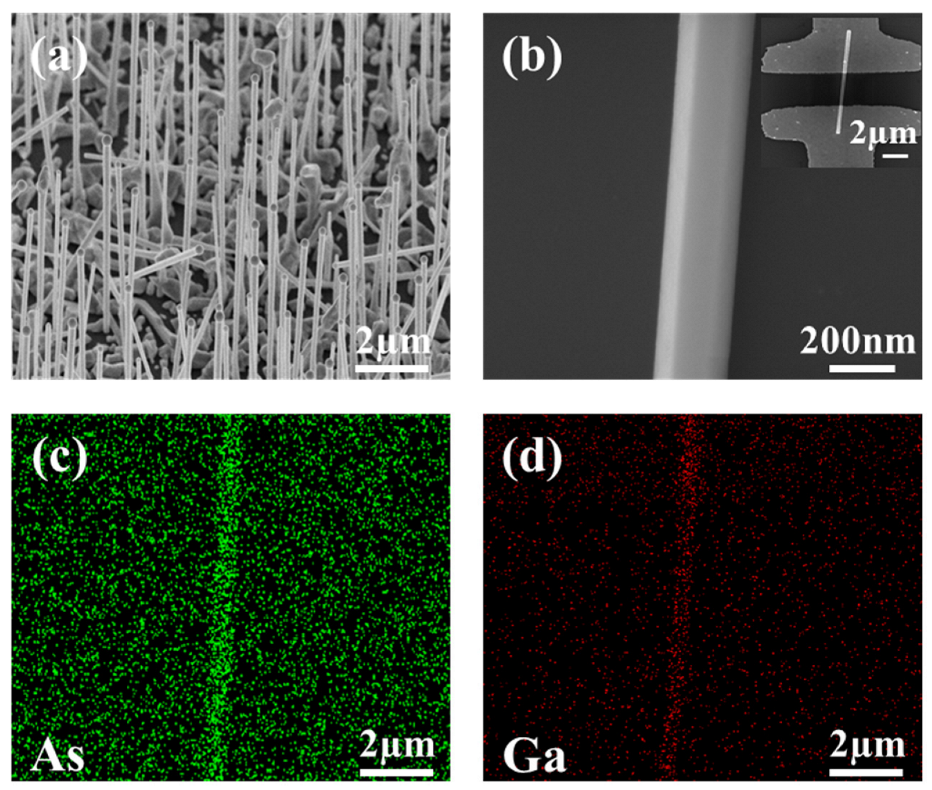
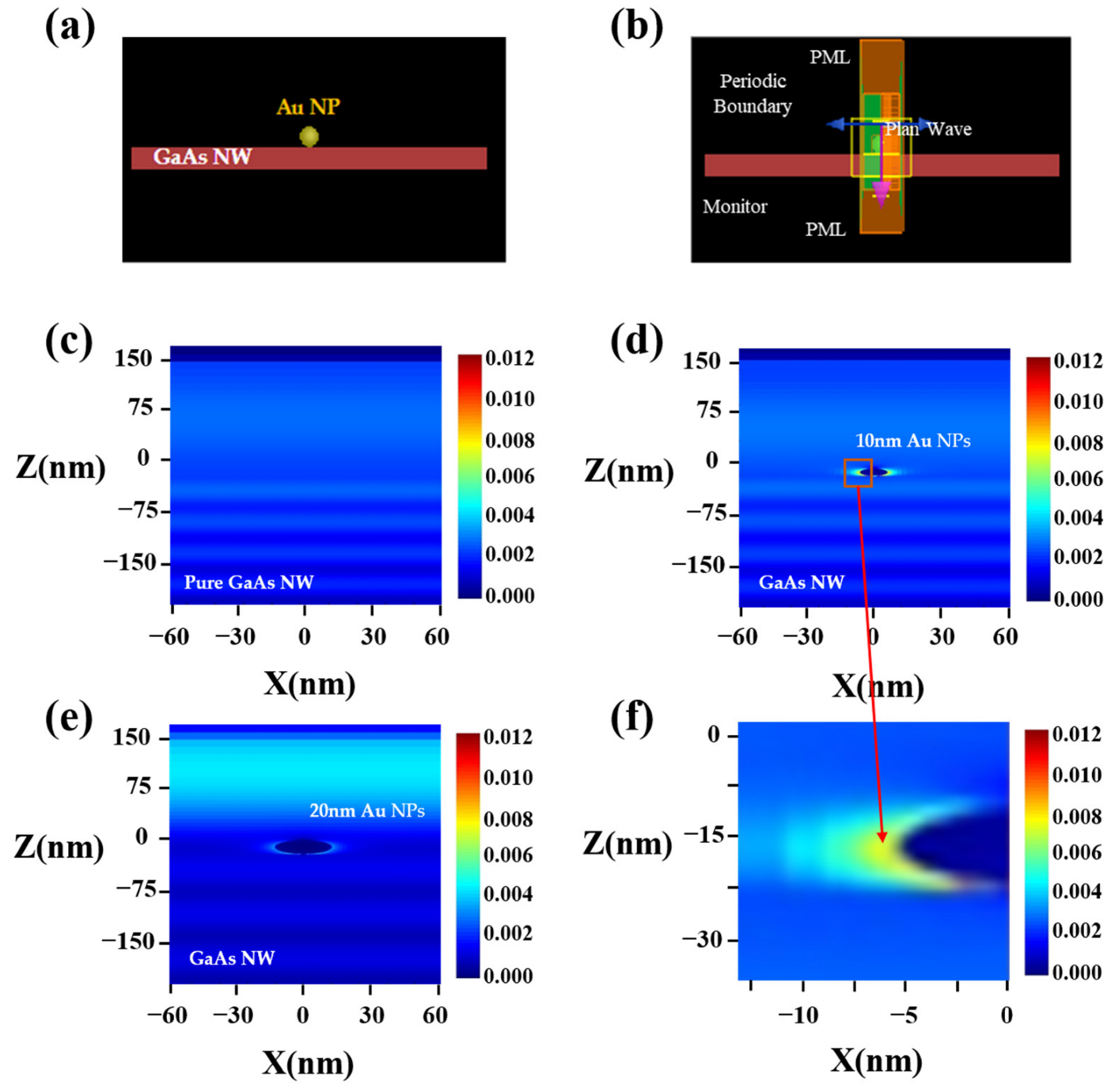
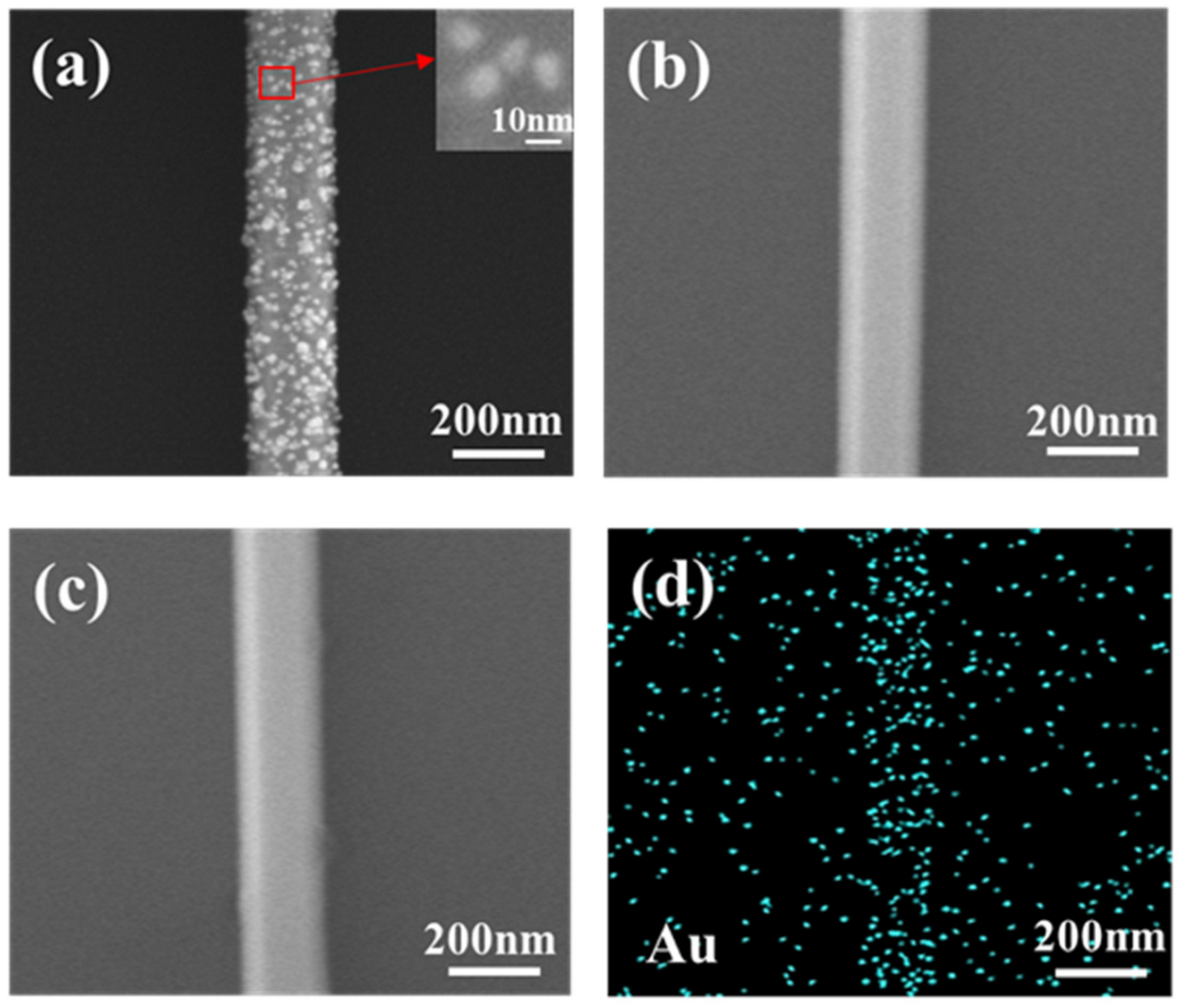

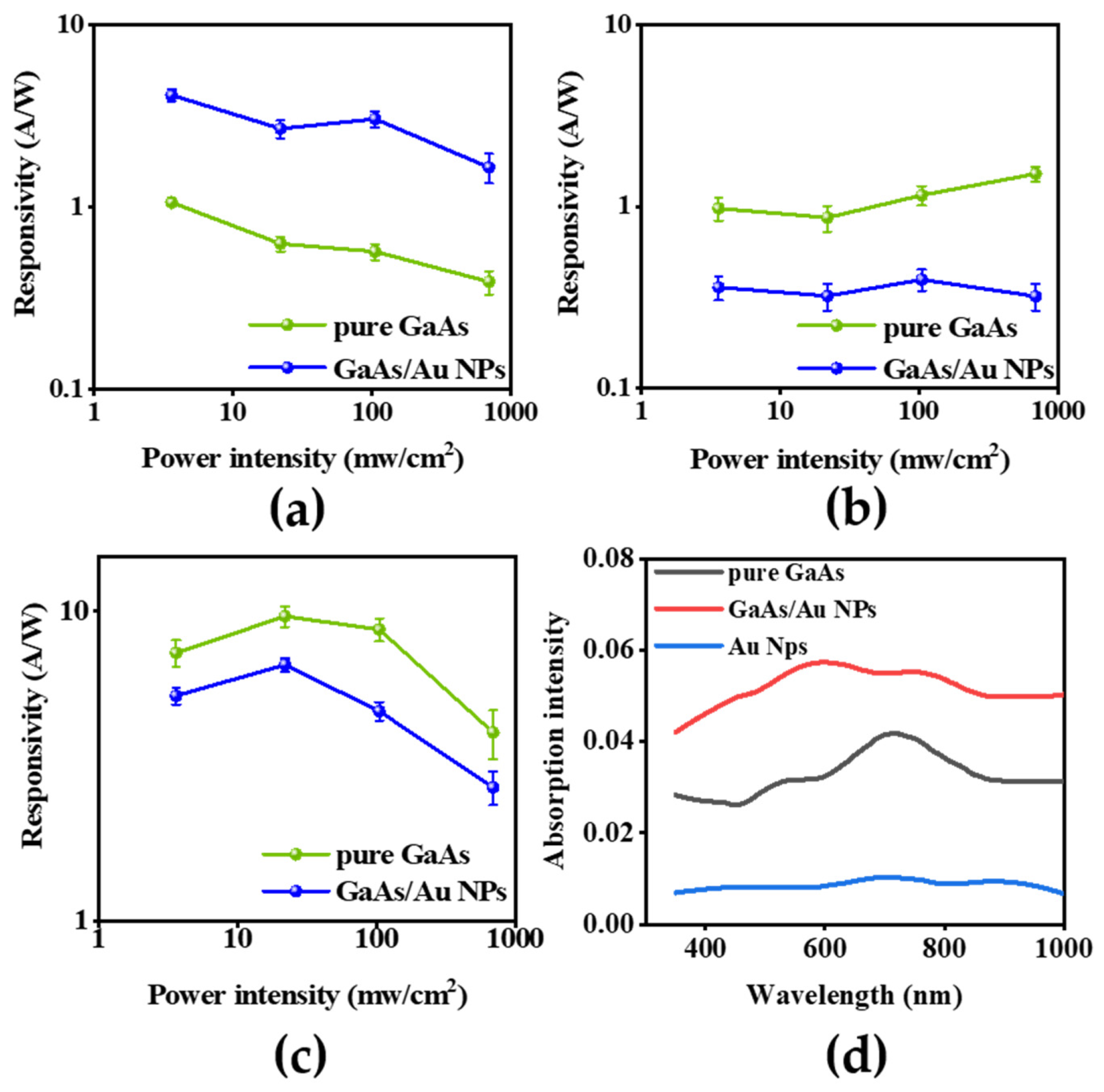
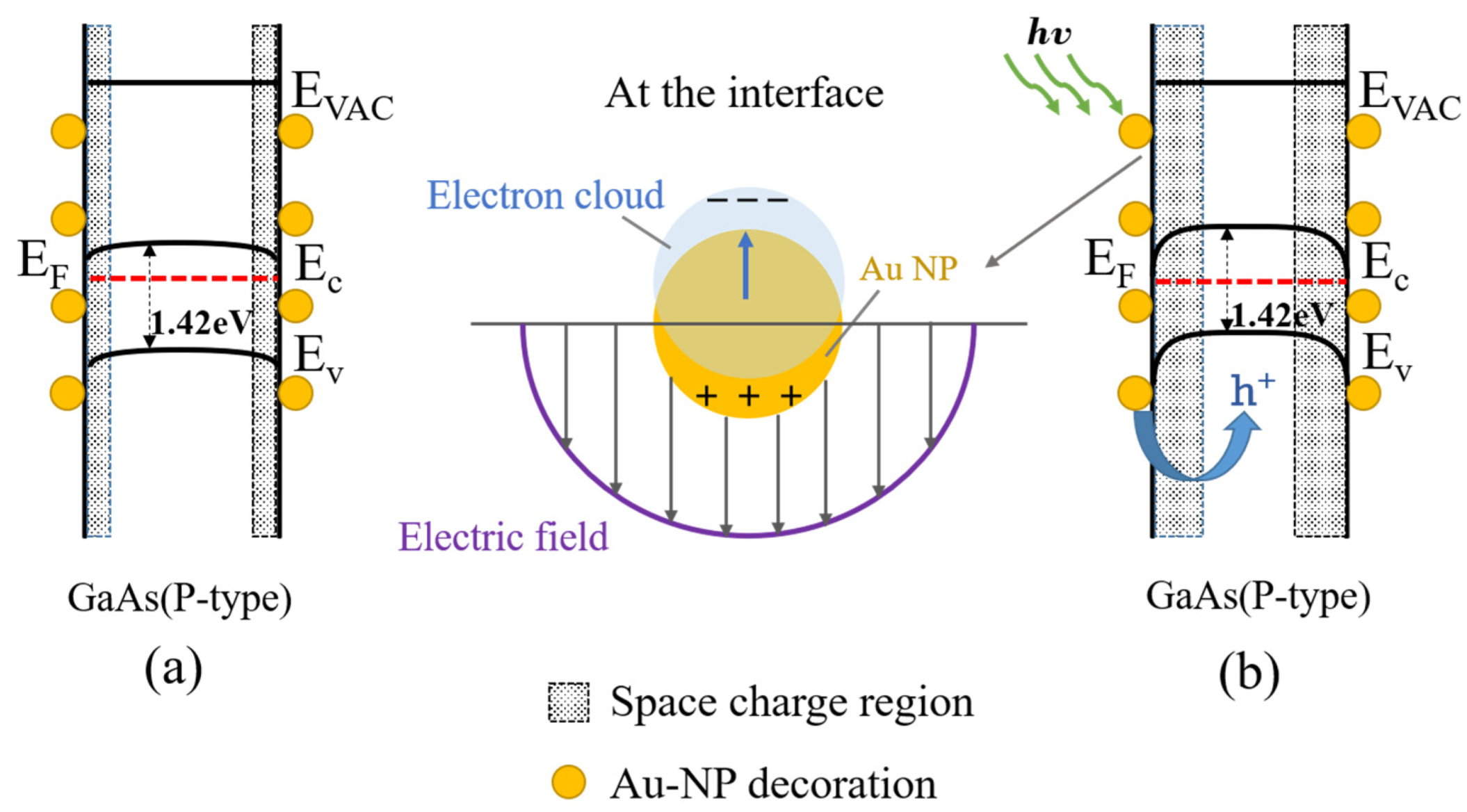
| Material | Idark (A) | Ilight (A) | R (A∙W−1) | Ref |
|---|---|---|---|---|
| Commercial GaAs | / | / | 0.45 | [16] |
| GaAsSb | 3 × 10−7 | 5 × 10−7 | 2.37 | [47] |
| GaAs/GaAsAl quantum well NW | 1.2 × 10−12 | 1.35 × 10−11 | 0.199 | [48] |
| GaAs NW, surface passivation | 7.18 × 10−14 | 1.8 × 10−10 | 18.2 to 25 | [16] |
| GaAs NW-Au NPs | 6.9 × 10−13 | 2.92 × 10−12 | 6.56 | [18] |
| GaAs NW | 4.84 × 10−12 | 2.39 × 10−10 | 0.569 | This work |
| GaAs NW-Au NPs | 1.95 × 10−12 | 1.28 × 10−9 | 3.047 | This work |
Disclaimer/Publisher’s Note: The statements, opinions and data contained in all publications are solely those of the individual author(s) and contributor(s) and not of MDPI and/or the editor(s). MDPI and/or the editor(s) disclaim responsibility for any injury to people or property resulting from any ideas, methods, instructions or products referred to in the content. |
© 2023 by the authors. Licensee MDPI, Basel, Switzerland. This article is an open access article distributed under the terms and conditions of the Creative Commons Attribution (CC BY) license (https://creativecommons.org/licenses/by/4.0/).
Share and Cite
Lin, F.; Cui, J.; Zhang, Z.; Wei, Z.; Hou, X.; Meng, B.; Liu, Y.; Tang, J.; Li, K.; Liao, L.; et al. GaAs Nanowire Photodetectors Based on Au Nanoparticles Modification. Materials 2023, 16, 1735. https://doi.org/10.3390/ma16041735
Lin F, Cui J, Zhang Z, Wei Z, Hou X, Meng B, Liu Y, Tang J, Li K, Liao L, et al. GaAs Nanowire Photodetectors Based on Au Nanoparticles Modification. Materials. 2023; 16(4):1735. https://doi.org/10.3390/ma16041735
Chicago/Turabian StyleLin, Fengyuan, Jinzhi Cui, Zhihong Zhang, Zhipeng Wei, Xiaobing Hou, Bingheng Meng, Yanjun Liu, Jilong Tang, Kexue Li, Lei Liao, and et al. 2023. "GaAs Nanowire Photodetectors Based on Au Nanoparticles Modification" Materials 16, no. 4: 1735. https://doi.org/10.3390/ma16041735
APA StyleLin, F., Cui, J., Zhang, Z., Wei, Z., Hou, X., Meng, B., Liu, Y., Tang, J., Li, K., Liao, L., & Hao, Q. (2023). GaAs Nanowire Photodetectors Based on Au Nanoparticles Modification. Materials, 16(4), 1735. https://doi.org/10.3390/ma16041735









